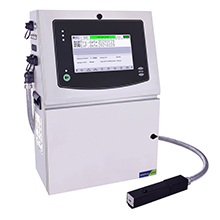What are the benefits of continuous inkjet printing system?
The working theory of a continuous inkjet printer is the nozzles of the print head eject electrically charged ink droplets, which subsequently pass through an electric field. The inkjet is broken up into droplets in the chamber by pulses from a piezoelectric crystal. The droplets needed for printing are charged by the electrodes as they break off from the inkjet, and the printer recirculates the remaining droplets. The charged droplets pass through an electrostatic field between deflector plates, and the combination of velocity and charge determines the exact position of the droplets on the substrate.

Regardless of porosity, size, shape and texture, information such as coding, dates, batches or bar codes, product names and logos can be easily printed on most materials with continuous inkjet printers. This facilitates data traceability and further aids compliance with industrial production policies.
Benefits of Continuous Inkjet Printing System
Versatility
The advantages of continuous inkjet printers can be attributed to their highest versatility and enhanced adaptability. They can work on virtually all media, regardless of speed and orientation. In addition, it can be used flexibly for different purposes, such as printing date codes, batch codes and logos, regardless of the material. Because continuous inkjet printers use non-contact technology, they can be used to emboss on any type of surface, whether it is curved, textured or porous. They can also use a wide variety of inks, providing many creative opportunities for product designers. Continuous inkjet printing is generally done directly on products that are usually irregularly shaped, rather than on packaging and boxes that are usually smooth. In addition, they can accommodate substance-specific coding, such as ethanol-containing inks for food, alcohol-resistant inks for plastics, UV-resistant inks, etc. All of this makes continuous inkjet printing very attractive, albeit in the industry.
Reliability
Continuous inkjet printers use high-pressure pumps to guide liquid ink through the nozzles to create a fast, continuous stream of ink droplets. Because the printer's nozzle never comes into contact with the substrate material, it can be used for clear, precise marks, independent of the material. The likelihood of smudges, misprints and damage is minimal, reducing material waste and time lost due to reprinting.
Printing Speed
The high inkjet frequency of continuous printer makes coding and marking faster. They are also suitable for 24/7 continuous operation, making them ideal for continuous production line requirements. Such speed is critical for identifying products in areas such as the food or pharmaceutical industries.
Recommended article:What are the key benefits of using metallic printing paper?
How BOPP Label Facestock Supports Eco-Friendly Packaging ?
Exploring the Versatility of Spirit Glass Bottles: Ideal for Spirits, Liquors, and More
Are Microwave Paper Bags Safe for Reheating Food?
What is The Impact of GRS Certification on the IML Food Packaging Industry?
Which Food Boxes Are Right for You?
What Makes Wet Strength Paper So Essential?
Fast-drying Inks
In practice, industrial marking is carried out at high speeds, with the product remaining in front of the print head for only a short period of time - during which the mark or text is printed by the continuous inkjet printer. The product is then quickly passed on to the next stage of the production line process. It is therefore crucial that the ink used dries as quickly as possible. Ink stains can affect readability, and manufacturers need to know that the printed information - for example, symbols, marks, bar codes and logos - is printed as clearly and distinctly as possible.
Continuous inkjet printers use inks that dry very quickly, reducing the possibility of smudges or misprints. Because the inkjet is always in use, the nozzles do not clog, allowing solvents such as ketones and alcohols to remain continuously deployed. These solvents are able to "bite" into the substrate and dry quickly, unlike other types of inks.
Cost Efficiency
Continuous inkjet printers help to significantly reduce operating costs. All of the above features save users time and money. In addition to this, continuous inkjet printers are able to work continuously with minimal service requirements. With their long-lasting performance, tough resistance to high production temperatures, dust, humidity and other environmental conditions, continuous inkjet printers can be the first choice on production lines. The printers also require little to no effort to maintain. Because continuous inkjet printers have fewer moving parts, most problems are easy to identify and simple to fix.
The significance of continuous inkjet printers is that the information printed not only serves as the axis of the product distribution cycle, but also keeps users informed of key facts about the product and helps them comply with safety requirements.
Docod Precision Group Co., Ltd. has been specializing in the design, development, production, sales and service of inkjet printing machines and parts products, and is committed to achieving a variety of marking solutions for users worldwide with superior technology.
Recommended article:Are Watch Winders Safe for Rolex?
How do you make plastic buckets?
A History of the Football Goalpost
How Long Can You Keep a Glass Bottle?
Is Reusing Glass Bottles OK?
What is a Magnetic Box?
The Benefits of Using Margarine Containers in Your Kitchen




